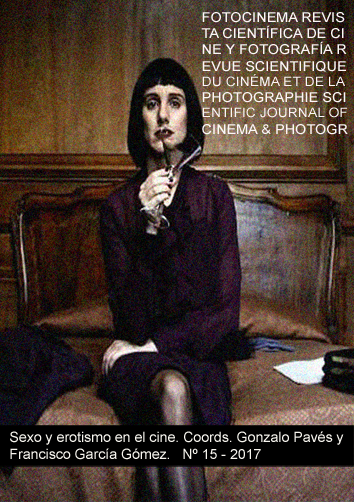PorNo Future: estética del totalitarismo en la bilogía “Latex” y “Shock”, de Michael Ninn
DOI:
https://doi.org/10.24310/Fotocinema.2017.v0i15.3515Keywords:
pornografía, totalitarismo, Michael Ninn, estética, Pornography, Totalitarianism, AestheticsAbstract
Durante los años 90, antes de los cambios definitivos que en la industria y la distribución de la pornografía introdujo la era digital, algunos directores cobraron un marcado protagonismo debido a su voluntad de elevar el género a nuevos estándares artísticos. En el porno heterosexual estadounidense destacó sobradamente Michael Ninn, quien, con su bilogía Latex (1995) y Shock (1996), se internó en lenguajes técnicos poco explorados, sirviendo al mismo tiempo una estética particular sobre el sexo y la dominación en los regímenes totalitarios, que además actúan como eje argumental de ambas películas. Este artículo explora sus aportaciones en este último plano, recorriendo los dos filmes mediante un breve análisis sobre la fascinación histórica por la relación entre sumisión y erotismo, las conexiones cinéfilas y las claves técnicas de las dos películas, y la exclusiva aplicación de estos conceptos a la tradicional exhibición del acto sexual con que Ninn las pergeñó.
Abstract:
During the 1990s, before the definitive changes introduced by the digital age, in industry and the distribution of pornography, some directors gained a marked role due to their willingness to elevate the genre to new artistic standards. The heterosexual american porn amply highlighted Michael Ninn, who, with his duology Latex (1995) and Shock (1996), was interned in unexplored technical languages, serving at the same time a particular aesthetic about sex and domination in totalitarian regimes, which also act as plot axis of both films. This article explores his contributions in this last plane, traveling the two films by a brief analysis of the historical fascination with the relationship between submission and eroticism, the active connections and technical keys of the two films, and the exclusive application of these concepts to the traditional display of the sexual act with that Ninn engineered them.
Downloads
Metrics
Publication Facts
Reviewer profiles N/A
Author statements
Indexed in
-
—
- Academic society
- N/A
- Publisher
- Universidad de Málaga
References
Blom, P. (2016). La fractura. Vida y cultura en Occidente, 1918-1938. Barcelona: Anagrama.
Corazón, A. (2013). La vida sexual en la Unión Soviética. Recuperado de: http://www.jotdown.es/2013/07/la-vida-sexual-en-la-union-sovietica
Cortés, J.M. (2010). La Ciudad Cautiva. Control y vigilancia en el espacio urbano. Madrid: Akal.
Foster Wallace, D. (2009): Hablemos de langostas. Barcelona: Debolsillo.
Gonzáles, J.D. (2012). Cuerpo y obscenidad en los medios: un acercamiento estético a la mediación intersubjetiva de la pornografía. Tesis presentada para optar al título de Magister en Estética. Recuperado de: http://www.bdigital.unal.edu.co/9159/1/71365712.2012.pdf
Hernández, C., Crespo, M. (2013). Apuntes sobre una sociología del porno. Apuntes de investigación del CECYP. Recuperado de: http://www.scielo.org.ar/scielo.php?script=sci_arttext&pid=S1851-98142013000200002
Meléndez, F. (2004). En VV.AA., Porn studies. Durham: Duke University Press.
Orwell, G. (1980). 1984. Recuperado de: https://blog.smaldone.com.ar/pdf/1984-bilingue.pdf
Pagés, N., Rubí, N. (2012). Eros Ausente: apuntes sobre la erotización del nazismo. Revista de Estudios sobre genocidio. Recuperado de http://revistagenocidio.com.ar/wp-content/uploads/2013/05/025-a-048.pdf
Posada, S. (2017). El mejor crítico de cine porno se destapa. Entrevista a Lucas Soler. Recuperado de: http://www.soho.co/historias/articulo/el-mejor-critico-de-cine-porno-se-destapa/30867
Purcell, N. (2012). Violence and the pornographic imaginary. The politics of sex, gender and agression in harcore pornography. Routledge: Nueva York.
Ruiz-Tagle, J. (2013). Creatividad y estereotipia en el sadomasoquismo. Revista Nomadías. Recuperado de http://www.nomadias.uchile.cl/index.php/NO/article/viewFile/29944/31723
Sade, Marqués de (Sin Fecha). Juliette, o las prosperidades del vicio. Recuperado de http://seronoser.free.fr/sade/1800%20Juliette%201.pdf
Sontag, S. (2011). Bajo el signo de Saturno. Barcelona: Debolsillo.
Zavala, I. (2014). La impudicia y lo obsceno en la cultura concemporánea. Errancia, revsita de Psicoanálisis, Teoría Crítica y Cultura. Recuperado de: http://www.iztacala.unam.mx/errancia/v9/PDFS_1/TEXTO%20LITORALES%201%20ERRANCIA%209.pdf
Zamiatin, E. (2008). Nosotros. Madrid: Akal.
Downloads
Published
How to Cite
Issue
Section
License
All contents published in Fotocinema Revista científica de cine y fotografía are protected under the Creative Commons Attribution-NonCommercial-ShareAlike 4.0 International (CC BY-NC-SA 4.0) license. All about this license is available in the following link: <http://creativecommons.org/licenses/by-nc-sa/4.0>
Users can copy, use, redistribute, share and exhibit publicly as long as:
- The original source and authorship of the material are cited (Journal, Publisher and URL of the work).
- It is not used for comercial purposes.
- The existence of the license and its especifications are mentioned.
There are two sets of authors’ rights: moral and property rights. Moral rights are perpetual prerogatives, unrenounceable, not-transferable, unalienable, imprescriptible and inembargable. According to authors’ rights legislation, Fotocinema. Revista científica de cine y fotografía recognizes and respects authors moral rights, as well as the ownership of property rights, which will be transferred to University of Malaga in open access. The property rights are referred to the benefits that are gained by the use or the dissemination of works. Fotocinema. Revista científica de cine y fotografía is published in an open access form and it is exclusively licenced by any means for doing or authorising distribution, dissemination, reproduction, , adaptation, translation or arrangement of works.
Authors are responsable for obtaining the necessary permission to use copyrighted images.














13.png)



